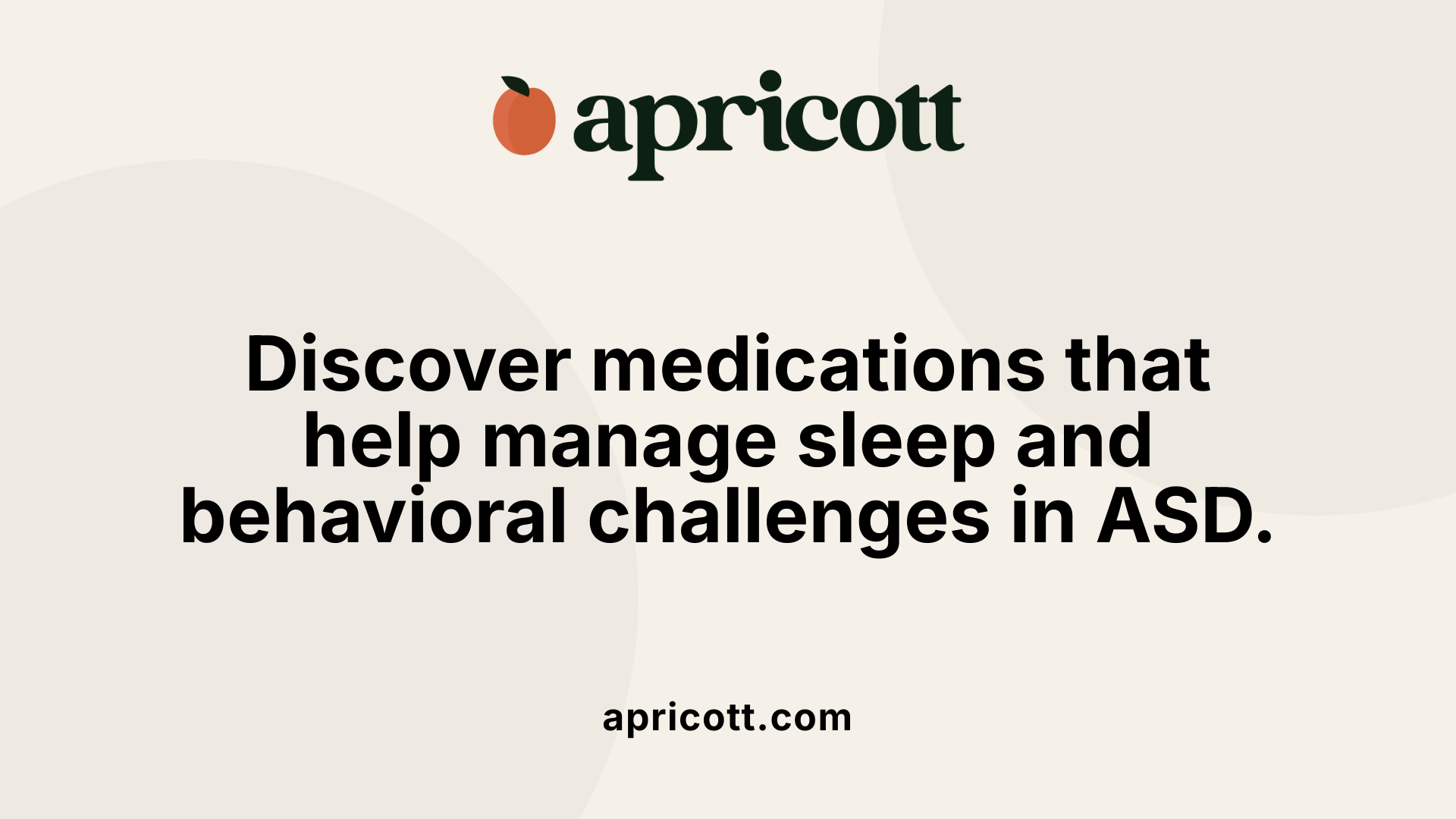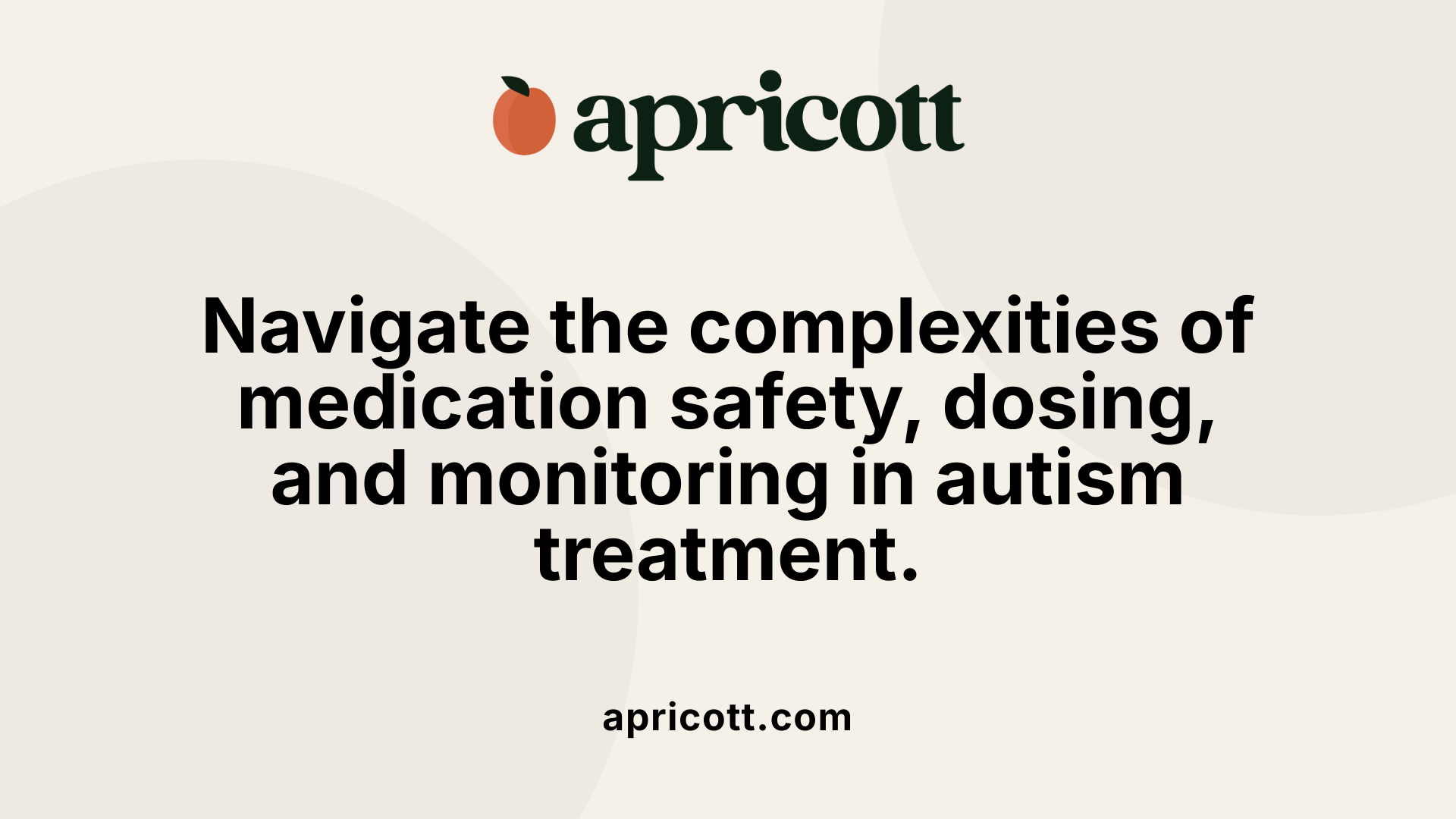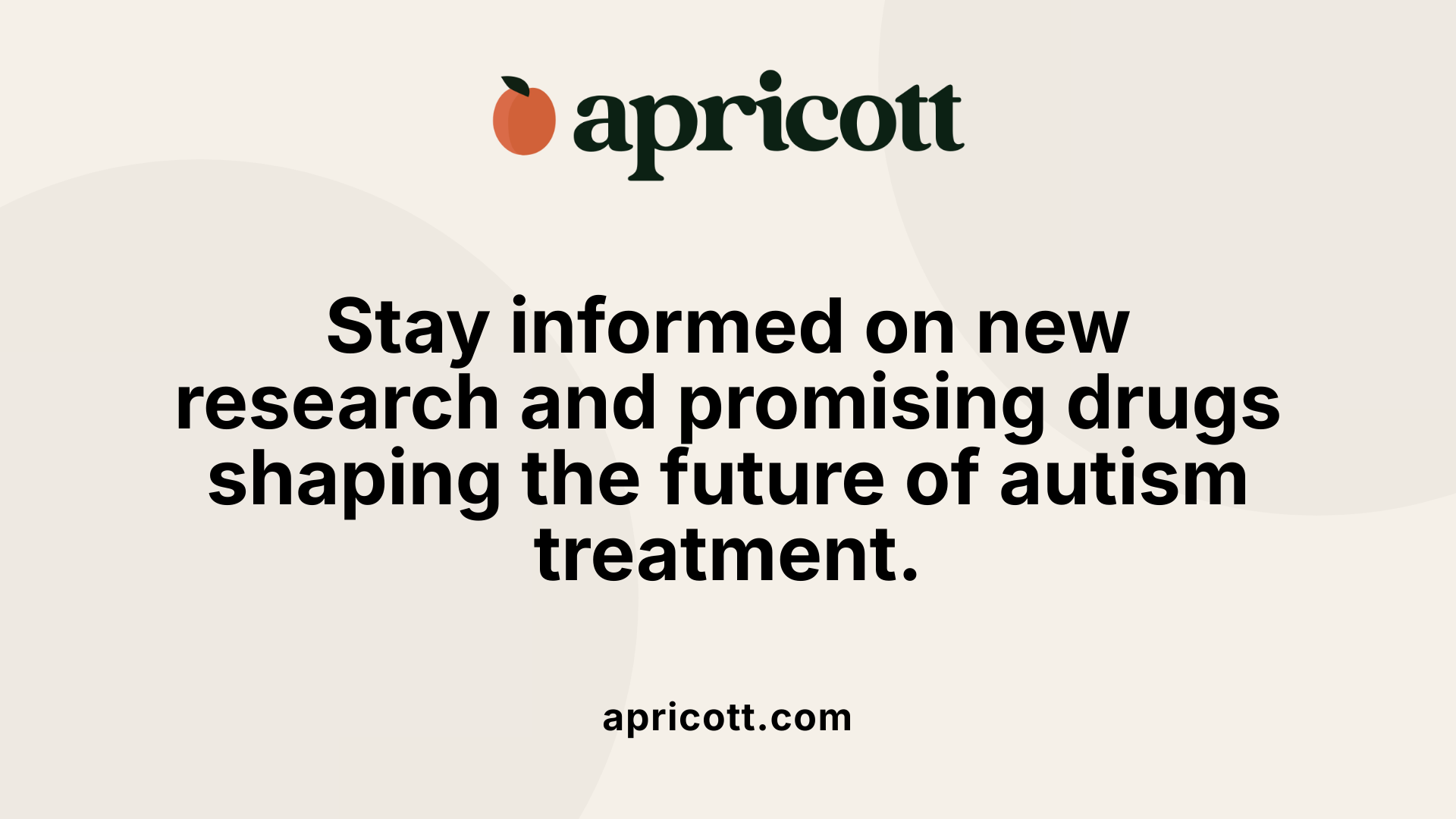Understanding the Intersection of Medication and Autism Therapies
Autism Spectrum Disorder (ASD) encompasses a broad range of developmental challenges primarily affecting communication, social interaction, and behavior. While there is no medication approved to treat the core symptoms of autism itself, pharmacological treatments play a critical role in managing associated conditions and behaviors that interfere with therapy and daily functioning. This article explores the complex landscape of medication usage for autism, emphasizing the importance of integrated treatment strategies alongside behavioral and developmental therapies for optimal outcomes.
The Foundations of Behavioral and Developmental Therapies in Autism

What is Applied Behavior Analysis (ABA) and its core principles?
Applied Behavior Analysis (ABA) is a widely recognized behavioral therapy for autism spectrum disorder (ASD). ABA is grounded in behavioral psychology and focuses on encouraging desired behaviors while discouraging undesired ones. Progress is continuously tracked and measured to ensure effectiveness. This approach helps teach new skills and supports applying them in various settings.
How do developmental therapies complement ABA?
Developmental therapies aim to improve essential skills like language, motor abilities, and sensory integration. Common developmental therapies include:
- Speech and Language Therapy: Helps enhance communication skills, incorporating gestures, sign language, or picture communication.
- Occupational Therapy (OT): Addresses sensory integration challenges and daily living skills such as dressing, eating, and handwriting.
- Physical Therapy (PT): Focuses on gross motor skills, coordination, and balance.
These therapies often work in tandem with behavioral methods to provide a holistic intervention plan.
Why is early intervention important?
Early intervention (EI) should begin as soon as ASD is diagnosed or suspected, ideally continuing for at least two years before school age. Starting therapy early significantly improves communication, social abilities, and cognitive development, setting a foundation for later learning and social integration.
What are key behavioral models used within ABA?
Several behavioral therapy models have proven effective:
- Pivotal Response Training (PRT): A naturalistic, play-based technique that focuses on increasing motivation and pivotal skills like initiating communication.
- Discrete Trial Training (DTT): A structured method breaking down skills into small, manageable steps, reinforced with rewards.
- Early Start Denver Model (ESDM): Designed for children aged 12 to 48 months, ESDM integrates ABA principles with developmental approaches, emphasizing play, social exchanges, and shared attention involving parents.
Collectively, these therapies form the foundation for effective ASD intervention, promoting skill development and adaptive behaviors in natural and structured environments.
Medication’s Role: Managing Symptoms, Not Curing Autism
Are there FDA-approved medications for core ASD symptoms?
Currently, there are no medications approved by the FDA that specifically treat the core symptoms of autism spectrum disorder (ASD) such as communication difficulties, social challenges, or repetitive behaviors. Medications do not cure autism itself but are used primarily to manage associated symptoms that interfere with daily functioning.
What symptoms do medications target in ASD?
Medications commonly target co-occurring symptoms in individuals with ASD, including:
- Irritability (e.g., tantrums, aggression, self-injurious behaviors)
- Anxiety and mood disorders
- Hyperactivity and attention deficits
- Sleep disturbances
FDA-approved drugs such as risperidone and aripiprazole are prescribed to reduce irritability and aggression in children aged 5 years and older. Other medications, like melatonin, are commonly used to improve sleep problems frequently seen in ASD.
How do medications work alongside behavioral therapies?
Pharmacological treatments serve as an important complement to behavioral therapies rather than a replacement. For example, managing irritability and anxiety can enhance a child's ability to participate effectively in therapies like Applied Behavior Analysis (ABA). Combining both approaches supports better overall outcomes.
Which symptoms are commonly managed by medications in ASD?
Commonly treated symptoms include:
| Symptom | Medications Used | Notes |
|---|---|---|
| Irritability | Risperidone, Aripiprazole | Approved for children 5-17 years; reduce aggression and tantrums |
| Anxiety/Mood | SSRIs, Buspirone, Mirtazapine | Used off-label with mixed evidence; some preferred over SSRIs |
| Hyperactivity/ADHD | Non-stimulants (Atomoxetine, Guanfacine) | Preferred over stimulants in some ASD cases |
| Sleep Problems | Melatonin | First-line medication improving sleep onset and quality |
In summary, medication in autism primarily helps manage symptoms that could otherwise obstruct learning and social engagement, enabling behavioral and educational therapies to be more effective.
FDA-Approved Medications for Autism-Related Irritability
What are the approved medications for irritability in autism?
Two medications are FDA-approved specifically to treat irritability in children and adolescents with autism spectrum disorder (ASD): risperidone and aripiprazole.
What improvements do these medications provide?
Both risperidone and aripiprazole have demonstrated effectiveness in reducing irritability, tantrums, aggression, and self-injurious behaviors common in ASD. These benefits support better behavioral regulation and overall functioning in affected children.
What do clinical trials reveal about their efficacy and safety?
Clinical trials have shown that risperidone significantly decreases not just irritability but also social withdrawal, stereotypic movements, hyperactivity, and inappropriate speech over extended periods, such as a 32-week trial. Aripiprazole studies report substantial improvements in irritability, hyperactivity, and stereotypy scores. Side effects noted for aripiprazole include weight gain, vomiting, nasopharyngitis, and increased appetite. Comparative studies indicate risperidone is generally more effective and better tolerated than haloperidol for aberrant social behavior in ASD.
What age groups are these medications approved for?
Risperidone is approved for children aged 5 years and older, while aripiprazole is approved for children and adolescents aged 6 to 17 years. This ensures treatment availability tailored to developmental stages relevant to ASD symptom management.
Off-Label Medications in Autism Treatment
How are SSRIs used for anxiety and depression in autism?
Selective serotonin reuptake inhibitors (SSRIs), such as sertraline, are commonly prescribed off-label to manage anxiety and depression in individuals with autism spectrum disorder (ASD). These medications help alleviate mood symptoms that often interfere with daily functioning and the ability to engage in behavioral therapies. However, SSRIs may carry the risk of behavioral activation, so careful monitoring is essential.
What non-stimulant medications are used for ADHD in ASD?
For attention-deficit/hyperactivity disorder (ADHD) symptoms co-occurring with ASD, non-stimulant medications like atomoxetine and guanfacine are frequently preferred, especially when patients have sleep disturbances or tics. Alpha-2 adrenergic agonists such as clonidine and guanfacine can also improve attention and hyperactivity while having a sedative effect that may benefit sleep.
What are the benefits and risks of off-label prescribing?
Off-label medication use enables clinicians to target specific co-occurring symptoms in autism that lack FDA-approved treatments, potentially improving quality of life. Nonetheless, off-label prescribing comes with challenges such as variable effectiveness, potential side effects, and the need to watch for tolerance or sensitization. Side effects might include weight changes, gastrointestinal issues, or behavioral shifts. Therefore, benefits should be carefully weighed against risks for each individual.
Why is individualized care and monitoring important?
Given the broad spectrum of ASD and its frequent comorbidities, treatment requires a personalized approach. Medication management should start with low doses and gradual adjustments while closely monitoring therapeutic response and adverse effects. Collaboration among healthcare providers, caregivers, and therapists ensures that medication complements behavioral interventions and adapts to changing needs. Regular follow-up and use of decision-support tools can optimize outcomes and safety.
Behavioral therapies form the foundation of autism care, and off-label medications play a supportive role in managing associated symptoms rather than core autism features.
Medications Targeting Sleep and Behavioral Regulation in ASD

Melatonin's Effectiveness in Sleep Disturbances
Melatonin is widely used as a first-line medication to improve sleep problems in children with autism spectrum disorder (ASD). Clinical trials report over 84% improvement in sleep disturbances, particularly in reducing sleep onset latency. It aligns with standard sleep hygiene recommendations and is considered safe and effective for managing sleep onset difficulties common in ASD.
Mirtazapine and Buspirone for Anxiety and Sleep
Mirtazapine shows promise in treating sleep disturbances and anxiety in ASD, demonstrating a trend toward clinical improvement in recent controlled trials. Buspirone is another option preferred for managing anxiety due to its lower risk of behavioral activation compared to selective serotonin reuptake inhibitors (SSRIs). Both medications also contribute to better sleep regulation, supporting overall behavioral stability.
α2-Adrenergic Agonists for ADHD with Coexisting Sleep Issues
For individuals with ASD and co-occurring ADHD, α2-adrenergic agonists such as clonidine and guanfacine are often favored over stimulant medications, especially when sleep disturbances or tics are present. These agents help improve attention and hyperactivity symptoms while also promoting better sleep quality, offering a dual benefit in this population.
Management Strategies for Common Co-Occurring Symptoms
Effective management of ASD frequently involves addressing associated symptoms including irritability, hyperactivity, anxiety, and sleep problems. Medications like risperidone and aripiprazole are FDA-approved to treat irritability and aggression but are used alongside behavioral therapies. Sleep disturbances are first managed with melatonin and behavioral strategies. Anxiety and mood issues may be addressed with mirtazapine or buspirone. A personalized, cautious approach of "starting low and going slow" with medications, combined with monitoring and integration of behavioral therapy, optimizes outcomes for children and adolescents with ASD.
Challenges and Considerations in Medication Management

Side Effects and Tolerance Development
Medications used in autism spectrum disorder (ASD) often come with potential side effects. For instance, risperidone and aripiprazole—FDA-approved drugs for managing irritability and aggression—have been associated with weight gain, increased appetite, vomiting, and nasopharyngitis. Additionally, some medications can lead to the development of tolerance or sensitization, reducing their effectiveness over time. This necessitates careful selection and ongoing evaluation of medication usage.
Starting Low and Going Slow Dosing Strategy
A fundamental principle in managing ASD-related medications is to start with the lowest possible dose and increase gradually. This "start low and go slow" approach helps minimize the risk of side effects while allowing healthcare providers to identify the optimal therapeutic dose for each individual. Because of the variability in how patients respond, individualized dosing plans are essential.
Monitoring for Metabolic and Behavioral Side Effects
Close monitoring is crucial, especially for metabolic concerns such as weight gain and prolactin levels, common with antipsychotic medications. Behavioral side effects must also be tracked, including any worsening of irritability or emergence of new symptoms. This ongoing assessment ensures timely adjustments to therapy and safeguards the patient's overall well-being.
Collaboration Among Caregivers, Healthcare Providers, and Therapists
Effective medication management is a team process involving family members, physicians, and therapy professionals. Caregivers provide vital observations about behavioral changes and side effects, while healthcare providers oversee medical aspects and adjust treatment as needed. Therapists contribute insights on how medications impact participation in behavioral interventions, facilitating an integrated approach that enhances treatment outcomes for individuals with ASD.
Emerging Pharmacological Therapies and Research Directions

What new compounds are being investigated to normalize brain functions in autism?
Recent advances in understanding the biology of autism spectrum disorder (ASD) have led to clinical trials testing new pharmacological compounds aimed at normalizing brain functions involved in autism. Investigational drugs include memantine and rivastigmine, which target cognitive aspects of ASD, with rivastigmine showing some positive effects in clinical evaluations. Other promising compounds under study are bumetanide, metformin, lovastatin, cannabidiol, arbaclofen, trofinetide, PDE4D inhibitors, and Anavex 2-73. These agents represent a shift toward treatments that may influence underlying neurobiological pathways rather than just managing symptoms.
How does oxytocin contribute to improving social functioning in ASD?
Oxytocin administered via intranasal sprays has demonstrated potential to enhance social functioning in children and adolescents with ASD. Clinical trials and case reports reveal improvements in areas such as emotion recognition and social behavior. While oxytocin is not yet an approved treatment, ongoing research suggests it could be part of future therapeutic strategies to address social challenges characteristic of autism.
What investigational drugs show promise for autism symptom management?
Several drugs are under clinical evaluation for their potential benefits in ASD. Trofinetide, specifically, has exhibited benefits particularly in subgroups with genetic etiologies like Rett syndrome and Fragile X syndrome. Other agents like memantine and rivastigmine focus on cognition enhancement, and lovastatin and metformin target metabolic pathways linked to genetic forms of ASD. These targeted treatments highlight a trend toward personalized medicine based on underlying genetic profiles.
Why is genetic testing important before starting pharmacological treatments?
Genetic testing—including assessments such as Fragile X screening, chromosomal microarray analysis, and whole exome/genome sequencing—is crucial before initiating treatment. Identifying specific genetic subgroups can guide clinicians to select targeted pharmacological therapies with higher likelihoods of efficacy. For instance, some medications like metformin or lovastatin have shown benefit in ASD forms associated with particular genetic anomalies. This personalized approach enhances treatment outcomes and reduces unnecessary medication exposure.
| Therapy/Compound | Purpose | Current Status/Notes |
|---|---|---|
| Oxytocin | Improve social functioning | Promising results in trials, not FDA approved yet |
| Memantine | Cognitive enhancement | Under investigation, mixed clinical results |
| Rivastigmine | Cognitive improvement | Some positive clinical effects |
| Trofinetide | Targeted for Rett syndrome, FXS | Beneficial in clinical trials for specific genetic subgroups |
| Metformin, Lovastatin | Genetic-specific treatments | Target metabolic pathways in Fragile X syndrome |
| Bumetanide, Cannabidiol | Neurobiology-based interventions | Experimental, ongoing trials |
| Genetic Testing | Precision in therapy selection | Important for personalized treatment plans |
Integrating Medication with Behavioral and Developmental Treatments
How Do Medications Support Therapy Engagement by Managing Disruptive Symptoms?
Medications play a crucial role in supporting behavioral and developmental therapies for individuals with autism spectrum disorder (ASD). While no medications treat core ASD symptoms directly, drugs like risperidone and aripiprazole help manage irritability, aggression, and self-injurious behaviors that can interfere with therapy participation. By reducing these disruptive symptoms, medications enable individuals to engage more effectively in interventions such as Applied Behavior Analysis (ABA) and speech therapy.
For example, managing anxiety with selective serotonin reuptake inhibitors (SSRIs) or improving sleep disturbances through melatonin can enhance focus and readiness for learning activities. Thus, medications serve as valuable adjuncts that complement therapeutic goals rather than replace foundational behavioral treatments.
Why Is a Multi-Modal Treatment Plan Important?
ASD presents with diverse challenges affecting communication, behavior, social skills, and physical abilities. Multi-modal treatment plans combine behavioral approaches (like ABA and discrete trial training), developmental therapies (such as occupational and speech therapy), and pharmacological interventions to address this complexity holistically.
Such integrated plans recognize that no single therapy addresses all symptoms. Behavioral methods structure learning and social skill acquisition, developmental therapies enhance motor and sensory integration, and medications alleviate co-occurring mental health or behavioral symptoms. This synergy improves overall outcomes by tailoring interventions to the individual's unique needs.
What Are Examples of Integrated Approaches Combining ABA, Occupational Therapy, and Medication?
- Early Start Denver Model (ESDM): A naturalistic ABA-based approach incorporating play and social exchanges, often paired with occupational therapy targeting sensory integration and motor skills.
- Pivotal Response Training (PRT): Focuses on motivation and initiating communication; medications managing anxiety or hyperactivity can enhance participation.
- Lovaas Model: Structured ABA sessions (20-40 hours/week) combined with therapies addressing speech and motor development, where medications may help control irritability to optimize learning.
This coordinated care maximizes the efficacy of individual components through concurrent implementation.
What Roles Do Families and Caregivers Play in Coordination?
Families and caregivers are essential in coordinating these multi-modal treatments. They monitor medication responses and side effects, communicate with healthcare providers and therapists, and reinforce therapeutic strategies at home. Family involvement also supports generalization of skills gained in therapy to everyday settings.
Effective collaboration between caregivers and multidisciplinary teams ensures personalized adjustments to treatment plans and promotes continuity of care across environments.
| Component | Role in Integrated Treatment | Example |
|---|---|---|
| Medication | Manages disruptive symptoms to improve therapy engagement | Risperidone reducing irritability |
| Behavioral Therapy | Teaches social, communication, and daily living skills | ABA, ESDM, PRT |
| Developmental Therapy | Enhances motor, sensory, and communication abilities | Occupational therapy, speech therapy |
| Family/Caregiver | Coordinates treatments, monitors progress, reinforces skills | Home-based support and monitoring |
Educational and Social-Relational Approaches Complementing Medication Use
What Are TEACCH Educational Programs?
TEACCH (Treatment and Education of Autistic and related Communication-handicapped Children) is an educational approach designed specifically for individuals with autism. It emphasizes structured teaching and visual learning techniques, relying on routine and predictability to help students thrive in classroom settings. This method fosters independence and improves communication by organizing the environment according to the learner's needs.
What Social-Relational Models Are Used in ASD?
Several social-relational approaches support children with ASD by enhancing their social interaction skills. These include:
- DIR/Floortime: Focuses on following the child’s interests to encourage emotional and relational development through play.
- Relationship Development Intervention (RDI): Aims to improve social skills by developing dynamic intelligence and adaptive interaction.
- Social Skills Groups: Offer a structured environment for practicing social interactions with peers.
- Social Stories: Use tailored stories to explain social situations and appropriate responses, helping children understand and cope with everyday interactions.
How Do These Therapies Fit Into Comprehensive ASD Treatment?
Educational and social-relational therapies serve as essential complements to medication and behavioral interventions. While medications manage associated symptoms like irritability or anxiety, these therapies build foundational social, communication, and adaptive skills. Integrating TEACCH, DIR/Floortime, and social skills groups ensures a holistic approach that addresses both behavioral challenges and social development.
The combination of educational, social-relational, behavioral, and pharmacological treatments fosters meaningful progress by tailoring interventions to each child’s unique profile and strengths.
Understanding the Role of Complementary and Alternative Therapies

What Complementary and Alternative Therapies Are Used in Autism?
Complementary and alternative therapies provide additional support for individuals with autism spectrum disorder (ASD) beyond conventional treatments.
Common approaches include art therapy and music therapy, which use creative expression to enhance communication and emotional skills. Animal therapy, such as equine-assisted activities or pet therapy, can boost social interaction and reduce anxiety. Mindfulness and relaxation therapies focus on stress reduction and emotional regulation, helping individuals manage daily challenges.
Why Is It Important to Discuss These Therapies with Healthcare Providers?
While these therapies can be beneficial, it is crucial to consult healthcare providers before starting any complementary approaches. A provider can ensure that the therapy is safe, appropriate, and coordinated with existing behavioral, educational, or medical treatments. They can also monitor progress and any unexpected effects.
What Cautions Should Be Taken Regarding Alternative Treatments?
Some alternative treatments lack scientific support and may carry risks. For example, special diets, chelation therapy, hyperbaric oxygen treatments, and intravenous immunoglobulin (IVIg) infusions have not been shown to benefit core ASD symptoms and might even be harmful. Families and caregivers should avoid unproven therapies without thorough research and medical advice.
By choosing evidence-based complementary therapies and working closely with healthcare teams, the overall support for individuals with autism can be maximized safely and effectively.
Behavioral Interventions: ABA and Its Variations
What is Early Intensive Behavioral Intervention (EIBI)?
Early Intensive Behavioral Intervention (EIBI) is a form of Applied Behavior Analysis (ABA) designed for young children under five years old. This approach involves intensive, structured teaching with 20 to 40 hours per week aimed at developing communication, social, and daily living skills. EIBI is individualized and emphasizes using reinforcers to motivate learning.
What is the Lovaas Method?
The Lovaas Method, a well-known ABA-based therapy, focuses on breaking down skills into small steps through discrete trials. It emphasizes language development and imitation using carefully chosen reinforcers tailored to each child. This method is typically used with children aged 2 to 8 years and involves a highly structured teaching environment to encourage skill acquisition and reduce problematic behaviors.
What are Naturalistic Developmental Behavioral Interventions?
Naturalistic Developmental Behavioral Interventions (NDBI), such as Pivotal Response Training (PRT) and the Early Start Denver Model (ESDM), combine principles of ABA with natural play-based interactions. These approaches focus on increasing motivation and communication skills in natural settings, targeting pivotal behaviors like initiating communication and social engagement. Parent involvement is often a core component of NDBI, promoting skills generalization beyond therapy sessions.
How do these methods focus on teaching skills and modifying behaviors?
All ABA-based variations share a foundational goal: to teach new skills and modify existing behaviors by reinforcing positive behaviors and discouraging undesired ones. Structured approaches like the Lovaas Method and discrete trial teaching break down complex tasks into manageable steps with consistent rewards, helping children learn efficiently. Naturalistic methods foster motivation and spontaneous communication within regular environments, enhancing real-world applicability. Together, these strategies help children with autism spectrum disorder develop essential communication, social, and adaptive skills while reducing challenging behaviors.
The Importance of Early Diagnosis and Intervention
Why is early intervention crucial in autism?
Early diagnosis of autism spectrum disorder (ASD) allows intervention to begin as soon as the condition is identified or suspected. Initiating evidence-based therapies before the child reaches school age—ideally during the toddler and preschool years—can significantly improve outcomes. Early intervention (EI) that lasts for at least two years focuses on enhancing communication, social, and cognitive skills, laying a critical foundation for later development.
How do early therapies improve skills?
Early intervention programs typically combine behavioral, developmental, and pharmacological approaches. These include applied behavioral analysis (ABA), speech therapy, occupational therapy, and physical therapy. ABA techniques, such as Pivotal Response Training (PRT) and Discrete Trial Teaching (DTT), encourage the acquisition of social and daily living skills. Developmental methods like the Early Start Denver Model (ESDM) incorporate naturalistic play and social interaction to enhance engagement and learning.
What is the role of combined therapies?
The integration of pharmacological treatments with behavioral and developmental therapies addresses both core ASD challenges and co-occurring symptoms such as irritability, anxiety, or attention difficulties. Medications like risperidone and aripiprazole are used cautiously to manage irritability and aggression, often aiding children in participating more effectively in therapy sessions. This comprehensive approach supports steady progress and skill generalization.
What is the impact on long-term prognosis?
Starting early and evidence-based interventions positively influences long-term cognitive, social, and adaptive functioning. Children receiving effective EI demonstrate improved communication, increased independence, and better social relationships during school age and beyond. Timely intervention helps reduce the severity of ASD-related challenges, ultimately enhancing quality of life and future expectations.
Medical and Psychiatric Comorbidities in Autism: Implications for Medication
What are common comorbidities in individuals with autism spectrum disorder (ASD)?
Many children with ASD also face a variety of medical and psychiatric comorbidities. Common medical issues include epilepsy, gastrointestinal problems, and sleep disturbances. Psychiatric conditions such as anxiety, depression, and attention deficit hyperactivity disorder (ADHD) frequently co-occur, complicating clinical presentation and treatment.
Why is comprehensive care important in managing ASD with comorbidities?
Effective management requires coordinated, comprehensive care that involves mental health professionals alongside pediatricians and developmental specialists. This multidisciplinary approach ensures that both core autism symptoms and co-occurring conditions receive appropriate attention, improving overall functioning and quality of life.
What pharmacological strategies address complex comorbid profiles in ASD?
Medications play a role in managing comorbid symptoms but do not treat the core features of autism. For instance, antiepileptic drugs control seizures in epilepsy, while selective serotonin reuptake inhibitors (SSRIs) or buspirone may be used for anxiety and mood disturbances. FDA-approved medications like risperidone and aripiprazole target irritability and aggression associated with ASD. Melatonin is commonly employed to improve sleep. Pharmacotherapy is most effective when integrated with behavioral therapies, with careful titration and monitoring to minimize side effects.
How are transition to adulthood and ongoing medical needs supported in individuals with ASD?
Transition periods, especially moving from adolescence to adulthood, introduce new challenges such as managing emerging social complexities and ongoing health concerns. Continued access to psychiatric care, medical management of chronic issues, and tailored support services are essential to promote independence and well-being. This holistic approach helps address both behavioral and medical aspects during critical life stages.
| Comorbidity Category | Examples | Pharmacological Considerations |
|---|---|---|
| Neurological | Epilepsy | Antiepileptics for seizure control |
| Gastrointestinal | Reflux, constipation | Symptom-specific treatments, often coordinated with GI specialists |
| Psychiatric | Anxiety, depression, ADHD | SSRIs, buspirone, stimulants/non-stimulants, atypical antipsychotics |
| Sleep | Sleep onset difficulties | Melatonin as first-line medication |
| Behavioral symptoms | Irritability, aggression | Risperidone, aripiprazole approved for irritability |
This integrated care model fosters improved clinical outcomes for individuals with ASD and complex comorbid presentations.
Balancing Medication and Multidisciplinary Therapies for Optimal Autism Care
Medication plays a critical supporting role in the treatment of autism spectrum disorder by targeting specific co-occurring symptoms such as irritability, anxiety, hyperactivity, and sleep disturbances. While these medications do not alter the core features of autism, they facilitate engagement in essential behavioral and developmental therapies that foster long-term skill acquisition and improved quality of life. Advances in pharmacological research, including novel compounds and genetic-informed treatments, hold promise for more targeted interventions in the future. For now, coordinated care among healthcare providers, therapists, families, and educators remains the cornerstone of effective ASD management, emphasizing individualized treatment, vigilance in monitoring, and a commitment to early and comprehensive intervention.
References
- Treatment and Intervention for Autism Spectrum Disorder
- Pharmacological Therapies for Autism Spectrum Disorder
- Medicines for Treating Autism's Core Symptoms
- Evidence-based Treatment Options for Autism
- Pharmacological treatment in autism: a proposal for ...
- Treatment Options
- Medication and Behavioral Interventions for Autism
- An Update on Psychopharmacological Treatment of Autism ...
- Autism spectrum disorder - Diagnosis and treatment
.svg)
.svg)








